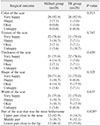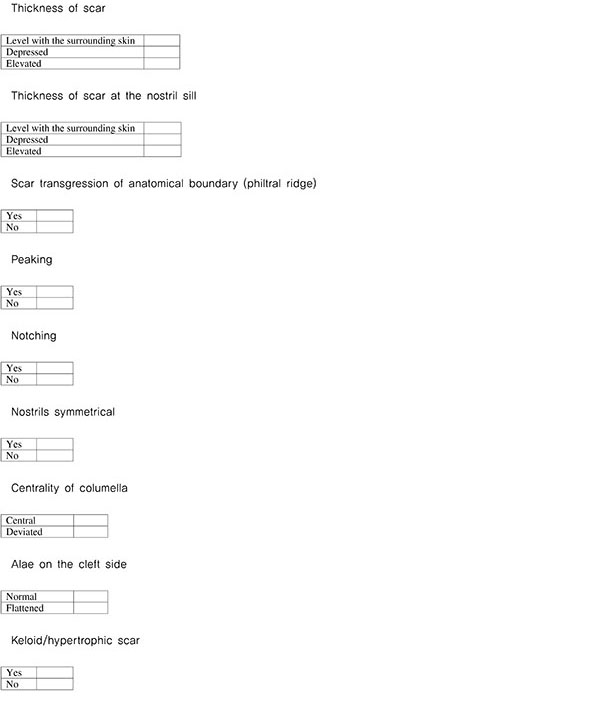1. Arosarena OA. Cleft lip and palate. Otolaryngol Clin North Am. 2007; 40:27–60. vi

2. Koppel D. Cleft lip and palate: developmental abnormalities of the face, mouth and jaws. In : Russell RCG, Williams NS, Bulstrode CJK, editors. Bailey & Love's short practice of surgery. 24th ed. London: Arnold;2004. p. 645–663.
3. Demke JC, Tatum SA. Analysis and evolution of rotation principles in unilateral cleft lip repair. J Plast Reconstr Aesthet Surg. 2011; 64:313–318.

4. Nwoku AL. Experiences on the surgical repair of unoperated adult cleft patients in Nigeria. Niger Med J. 1976; 4:417–421.
5. Tan O, Atik B. Triangular with Ala nasi (TAN) repair of unilateral cleft lips: a personal technique and early outcomes. J Craniofac Surg. 2007; 18:186–197.
6. van de Ven B, Defrancq J, Defrancq E. Cleft lip surgery: a practical guide. Zgierz: Drukarnia WIST;2008. p. 1–27.
7. Christofides E, Potgieter A, Chait L. A long term subjective and objective assessment of the scar in unilateral cleft lip repairs using the Millard technique without revisional surgery. J Plast Reconstr Aesthet Surg. 2006; 59:380–386.

8. Nollet PJ, Kuijpers-Jagtman AM, Chatzigianni A, Semb G, Shaw WC, Bronkhorst EM, et al. Nasolabial appearance in unilateral cleft lip, alveolus and palate: a comparison with Eurocleft. J Craniomaxillofac Surg. 2007; 35:278–286.

9. Asher-McDade C, Roberts C, Shaw WC, Gallager C. Development of a method for rating nasolabial appearance in patients with clefts of the lip and palate. Cleft Palate Craniofac J. 1991; 28:385–390. discussion 390-1.

10. Roberts CT, Semb G, Shaw WC. Strategies for the advancement of surgical methods in cleft lip and palate. Cleft Palate Craniofac J. 1991; 28:141–149.

11. Rullo R, Carinci F, Mazzarella N, Festa VM, Farina A, Morano D, et al. Delaire's cheilorhinoplasty: unilateral cleft aesthetic outcome scored according to the EUROCLEFT guidelines. Int J Pediatr Otorhinolaryngol. 2006; 70:463–468.

12. Farkas LG, Hajnis K, Posnick JC. Anthropometric and anthroposcopic findings of the nasal and facial region in cleft patients before and after primary lip and palate repair. Cleft Palate Craniofac J. 1993; 30:1–12.

13. Johnson N, Sandy J. An aesthetic index for evaluation of cleft repair. Eur J Orthod. 2003; 25:243–249.

14. Kernahan DA, Stark RB. A new classification for cleft lip and cleft palate. Plast Reconstr Surg Transplant Bull. 1958; 22:435–441.

15. Kernahan DA. The striped Y--a symbolic classification for cleft lip and palate. Plast Reconstr Surg. 1971; 47:469–470.

16. Randall P. A triangular flap operation for the primary repair of unilateral clefts of the lip. Plast Reconstr Surg Transplant Bull. 1959; 23:331–347.

17. Millard DR. A primary camouflage of the unilateral harelook. In : Shoog T, Ivy RH, editors. Transactions of the International Society of Plastic Surgeons. Baltimore: Williams & Wilkins;1957. p. 160–166.
18. Evans CA. Index may show outcome differences in unilateral cleft lip and palate patients at 5-years of age. Evid Based Dent. 1999; 1:7.

19. Gundlach KK, Schmitz R, Maerker R, Bull HG. Late results following different methods of cleft lip repair. Cleft Palate J. 1982; 19:167–171.
20. de Silva Amaratunga NA. Combining Millard's and Cronin's methods of unilateral cleft lip repair - a comparative study. Asian J Oral Maxillofac Surg. 2004; 16:5–9.

21. Dyalram-Silverberg D, Jamali M, Hoffman D, Lazow SK, Berger JR. Poster 23: comparison of the rotational advancement flap and an anatomical subunit approximation technique for closure of unilateral cleft lip. J Oral Maxillofac Surg. 2009; 67:Suppl. 80–81.

22. Bilwatsch S, Kramer M, Haeusler G, Schuster M, Wurm J, Vairaktaris E, et al. Nasolabial symmetry following Tennison-Randall lip repair: a three-dimensional approach in 10-year-old patients with unilateral clefts of lip, alveolus and palate. J Craniomaxillofac Surg. 2006; 34:253–262.

23. Sameh E, Amr S, Ashraf E. Evaluation of primary unilateral cleft lip repair: a proposed scoring system. Egypt J Surg. 2009; 28:4–7.
24. Meyer E, Seyfer A. Cleft lip repair: technical refinements for the wide cleft. Craniomaxillofac Trauma Reconstr. 2010; 3:81–86.

25. Reddy SG, Reddy RR, Bronkhorst EM, Prasad R, Kuijpers Jagtman AM, Bergé S. Comparison of three incisions to repair complete unilateral cleft lip. Plast Reconstr Surg. 2010; 125:1208–1216.

26. Zaleckas L, LinkeviXMLLink_XYZienXMLLink_XYZ L, Olekas J, Kutra N. The comparison of different surgical techniques used for repair of complete unilateral cleft lip. Medicina (Kaunas). 2011; 47:85–90.

27. Holtmann B, Wray RC. A randomized comparison of triangular and rotation-advancement unilateral cleft lip repairs. Plast Reconstr Surg. 1983; 71:172–179.

28. Chowdri NA, Darzi MA, Ashraf MM. A comparative study of surgical results with rotation-advancement and triangular flap techniques in unilateral cleft lip. Br J Plast Surg. 1990; 43:551–556.

29. Tobiasen JM, Hiebert JM, Boraz RA. Development of scales of severity of facial cleft impairment. Cleft Palate Craniofac J. 1991; 28:419–424.

30. Tobiasen JM, Hiebert JM. Facial impairment scales for clefts. Plast Reconstr Surg. 1994; 93:31–41. discussion 42-3.

31. Al-Omari I, Millett DT, Ayoub AF. Methods of assessment of cleft-related facial deformity: a review. Cleft Palate Craniofac J. 2005; 42:145–156.

32. Abdurrazaq TO, Micheal AO, Lanre AW, Olugbenga OM, Akin LL. Surgical outcome and complications following cleft lip and palate repair in a teaching hospital in Nigeria. Afr J Paediatr Surg. 2013; 10:345–357.

33. Thomas PT, Turner SR, Rumsey N, Dowell T, Sandy JR. Satisfaction with facial appearance among subjects affected by a cleft. Cleft Palate Craniofac J. 1997; 34:226–231.

34. Chait L, Kadwa A, Potgieter A, Christofides E. The ultimate straight line repair for unilateral cleft lips. J Plast Reconstr Aesthet Surg. 2009; 62:50–55.

35. Fudalej P, Katsaros C, Bongaarts C, Dudkiewicz Z, Kuijpers-Jagtman AM. Nasolabial esthetics in children with complete unilateral cleft lip and palate after 1-versus 3-stage treatment protocols. J Oral Maxillofac Surg. 2009; 67:1661–1666.

36. Millard DR. Extensions of the rotation-advancement principle for wide unilateral cleft lips. Plast Reconstr Surg. 1968; 42:535–544.

37. Mulliken JB, Martínez-Pérez D. The principle of rotation advancement for repair of unilateral complete cleft lip and nasal deformity: technical variations and analysis of results. Plast Reconstr Surg. 1999; 104:1247–1260.

38. Horswell BB, Castiglione CL, Poole AE, Assael LA. The double-reversing Z-plasty in primary palatoplasty: operative experience and early results. J Oral Maxillofac Surg. 1993; 51:145–149. discussion 149-50.

39. Cheema SA, Asim M, Ahmad A. Comparison of outcomes between linear versus triangular flap repair techniques at vermilion in unilateral cleft lip repair. J Ayub Med Coll Abbottabad. 2012; 24:75–77.
40. Adenwalla HS, Narayanan PV. Primary unilateral cleft lip repair. Indian J Plast Surg. 2009; 42 Suppl. S62–S70.

41. Kumar V, Abbas AK, Fausto N. Robbins and Cotran pathologic basis of disease. 7th ed. Philadelphia: Elsevier Saunders;2005. p. 113–117.
42. Edward E. Management of patients with orofacial clefts. In : Peterson LJ, Ellis E, Hupp JR, Tucker MR, editors. Contemporary oral and maxillofacial surgery. 4th ed. Estados Unidos: Mobsy;2003. p. 633.








 PDF
PDF ePub
ePub Citation
Citation Print
Print











 XML Download
XML Download